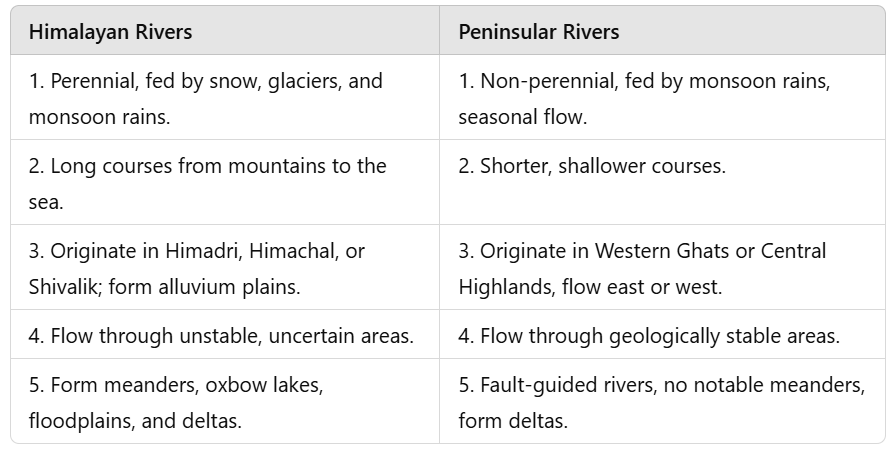Class 9 Geography Chapter 1 Question Answers - Contemporary India - I
Q1. What are the differences between the Himalayan rivers and the Peninsular rivers? (Important)
Ans: The differences between the Himalayan rivers and the Peninsular rivers are as follows:

Q2. Write a note on the Indus Drainage System.
Ans: The Indus River is one of the world's longest rivers, stretching approximately 2900 km. It begins near Lake Mansarovar in Tibet and flows westward, entering India in Ladakh, where it creates a stunning gorge.
Several tributaries join the Indus in the Kashmir region, including:
- Zaskar
- Nubra
- Shyok
- Hunza
The river continues through Baltistan and Gilgit, emerging at Attock. Its major tributaries, such as the Jhelum, Chenab, Ravi, Beas, and Satluj, converge near Mithankot in Pakistan.
From there, the Indus flows southward, ultimately reaching the Arabian Sea, east of Karachi. The Indus basin spans parts of Jammu and Kashmir, Himachal Pradesh, and Punjab in India, with the majority located in Pakistan. The plain of the Indus has a very gentle slope.
Q3. Write a note on the Brahmaputra Drainage System. OR Name any two major river systems of the Himalayan region. Describe any one in detail.
Ans: The Brahmaputra is one of the longest rivers in the world, originating in Tibet near Mansarovar Lake, where it is known as Tsangpo. It flows eastward alongside the Himalayas in a cold, dry region, resulting in lower water and silt levels.
Key features of the Brahmaputra include:
- At Namcha Barwa (7757 m), the river makes a U-turn and enters Arunachal Pradesh, where it is called Dihang.
- It is joined by several tributaries, including the Dibang, Lohit, and Kenula, increasing its volume as it flows into Assam.
- During the monsoon season, heavy rainfall raises its water and silt content, leading to severe floods in Assam and Bangladesh.
- The river creates braided channels and riverine islands, such as Majuli, the largest riverine island globally.
- In Bangladesh, it is referred to as Jamuna and merges with the Ganga (Padma) to form the Ganga-Brahmaputra Delta (Sunderbans), before flowing into the Bay of Bengal.
Q4. Write a note on the Ganga Drainage System. (Important)
Ans: The Ganga is the longest river in India, stretching over 2500 km. Its basin primarily lies in India, with a portion in Bangladesh. Key features of the Ganga Drainage System include:
- The river originates as the Bhagirathi from the Gangotri Glacier and merges with the Alaknanda at Devaprayag.
- It enters the plains at Haridwarand is joined by several tributaries, including:
- Yamuna (right bank) from the Yamunotri Glacier at Allahabad.
- Left bank tributaries: Ghaghra, Gandak, Kosi, and Sarda.
- Right bank tributaries: Chambal, Betwa, and Son.
- The Ganga and its tributaries create the fertile northern plains, essential for agriculture.
- As it flows eastwards, the river increases in volume until it reaches Farakka in West Bengal, where it bifurcates.
- In Bangladesh, it merges with the Brahmaputra to form the Ganga-Brahmaputra Delta, known as the Sundarbans, the world's largest and fastest-growing delta.
Q5. Write a note on the east-flowing and the west-flowing rivers of Peninsular India.
Ans: Peninsular India features a variety of rivers that flow in two main directions: east and west.
East-flowing rivers include:
- Mahanadi
- Godavari
- Krishna
- Kaveri
These rivers:
- Originate from the Western Ghats or the Deccan Plateau
- Flow eastward into the Bay of Bengal
- Have wide basins and create large deltas at their mouths
West-flowing rivers include:
- Narmada
- Tapi
- Others like Sabarmati, Mahi, Bharathpuzha, and Periyar
These rivers:
- Originate from the Satpura Range and Amarkantak Hills
- Flow westward into the Arabian Sea
- Have shorter, swifter courses and form estuaries rather than deltas
Q6. Why are rivers important for a country's economy?
Ans: Rivers play a crucial role in a country's economy due to several key benefits:
- Fertile Land: Rivers create alluvial plains that support agriculture.
- Water Supply: They provide essential water for domestic, agricultural, and industrial use.
- Irrigation: Rivers facilitate irrigation, which is vital for crop production, especially in countries like India.
- Transportation: They offer a cost-effective means of transport for goods via inland navigation.
- Hydroelectric Power: Rivers are a source of hydroelectric power, benefiting industries and households.
- River Valley Projects: Initiatives like dam construction enhance water management for irrigation, power generation, fishing, and recreation.
Overall, rivers are integral to economic development and sustainability.
|
55 videos|525 docs|78 tests
|
FAQs on Class 9 Geography Chapter 1 Question Answers - Contemporary India - I
| 1. What are the different types of drainage systems used in urban areas? |  |
| 2. How does poor drainage affect the environment? |  |
| 3. What are the signs of a drainage problem in a residential area? |  |
| 4. What maintenance practices can improve drainage systems? |  |
| 5. How can I determine the best drainage solution for my property? |  |

















